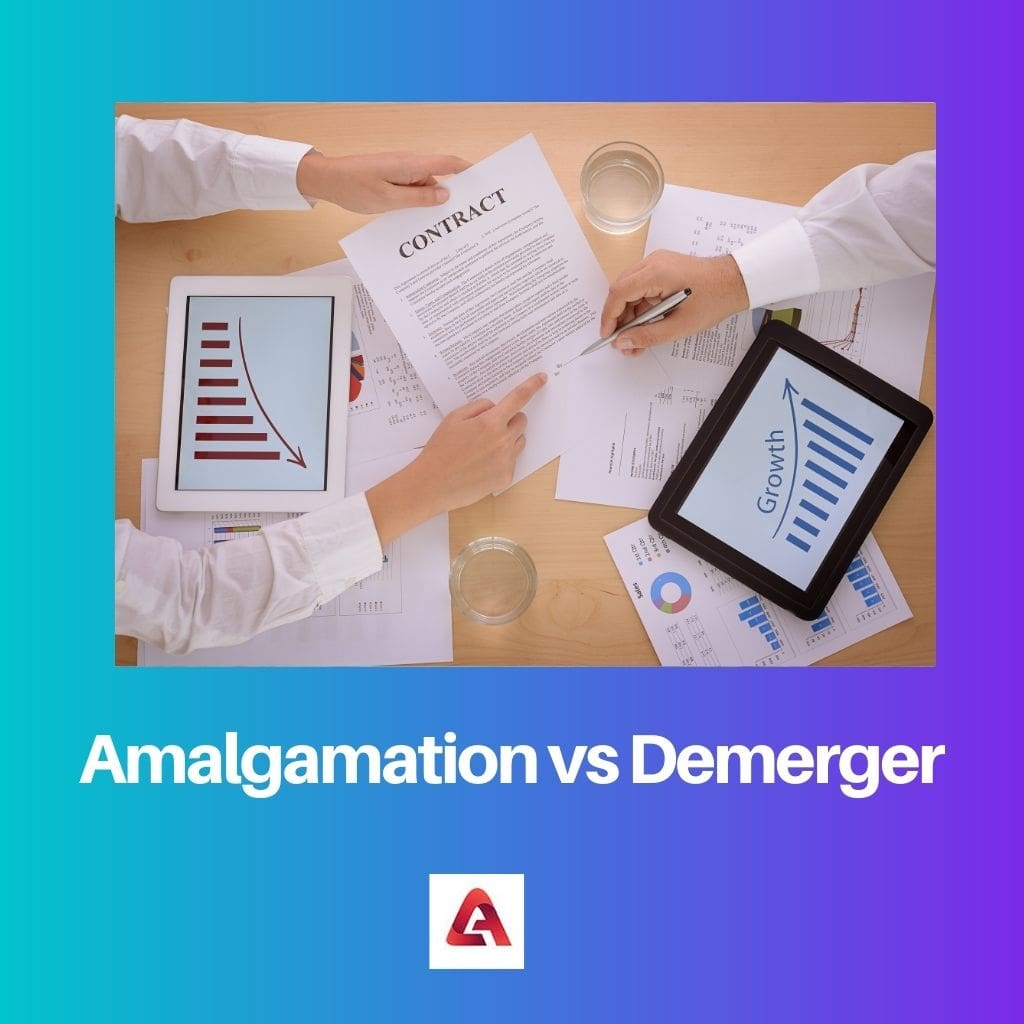Amalgamation involves the merging of two or more companies into one entity, consolidating their assets, liabilities, and operations. Demerger, on the other hand, entails the separation of a company into distinct entities, to streamline operations or unlock shareholder value by focusing on specific business segments.
Key Takeaways
- Amalgamation is the process of combining two or more companies into a single entity; demerger separates a company into two or more distinct entities.
- Amalgamation aims to create synergies, cost savings, and market expansion; demerger focuses on enhancing operational efficiency, management focus, and unlocking shareholder value.
- In amalgamation, assets and liabilities of the merging companies are combined, while demerger involves distributing assets and liabilities among the newly created entities.
Amalgamation vs Demerger
Amalgamation is the process of two or more companies merging into a single entity, resulting in the creation of a new company. Demerger is the separation of a company’s operations or assets into two or more separate entities, which may be done through spin-offs, carve-outs, or split-offs.

Amalgamation is a process where many companies give up their assets and income to another company and amalgamate with the latter. This may be due to the financial crisis or their business interest loss.
When merging occurs, only the shareholders with more than 75% share in the former company can have claims in the merged company.
The demerger is a process in which some of the portions of a company are bought by another company, or they undertake the former company. This process occurs primarily due to financial problems or the shortage of labourers. The shareholders are equally respected in both companies.
Comparison Table
| Feature | Amalgamation | Demerger |
|---|---|---|
| Definition | Joining of two or more companies to form a new company. | Separation of a company into two or more separate companies. |
| Purpose | To achieve economies of scale, diversification, or to create a stronger financial position. | To unlock the value of a subsidiary, focus on core business, or settle ownership disputes. |
| Initiating company | Acquirer company | Transferor company |
| Resulting company | New company is formed | Two or more new companies are formed |
| Shareholders | Shareholders of the merging companies receive shares in the new company. | Shareholders of the transferor company receive shares in the new companies in proportion to their holdings in the transferor company. |
| Creditors | Creditors of the merging companies become creditors of the new company. | Creditors of the transferor company become creditors of the new companies in accordance with a scheme of arrangement. |
| Employees | Employees of the merging companies may be transferred to the new company. | Employees of the transferor company may be transferred to the new companies, or they may be made redundant. |
| Accounting treatment | The assets and liabilities of the merging companies are combined in the financial statements of the new company. | The assets and liabilities of the transferor company are divided between the new companies in accordance with a scheme of arrangement. |
| Tax implications | There may be tax implications for the merging companies and their shareholders. | There may be tax implications for the transferor company and its shareholders. |
| Regulatory approvals | May require approval from regulatory authorities. | May require approval from regulatory authorities. |
What is Amalgamation?
Introduction to Amalgamation
Amalgamation refers to the process of combining two or more entities into a single entity. It is a strategic business decision undertaken by companies to achieve various objectives such as expansion, diversification, synergies, or cost efficiencies. Amalgamation can take several forms, including mergers, acquisitions, or consolidations, depending on the structure and dynamics of the entities involved.
Types of Amalgamation
- Mergers: Mergers occur when two or more companies mutually agree to combine their operations, assets, and liabilities to form a new entity. This new entity assumes ownership of the combined resources and continues operations under a unified management structure.
- Acquisitions: In an acquisition-based amalgamation, one company (the acquirer) purchases the assets and/or shares of another company (the target). The target company may continue to operate independently, or its operations may be integrated into those of the acquirer.
Key Drivers of Amalgamation
- Strategic Expansion: Amalgamation allows companies to expand their market presence, product offerings, or geographic reach. By combining resources, companies can access new markets, customers, and distribution channels, facilitating growth and market penetration.
- Synergy Realization: Synergies, such as cost savings, revenue enhancement, or operational efficiencies, are key drivers of amalgamation. By consolidating operations, eliminating redundancies, and leveraging complementary strengths, companies can achieve synergies that enhance overall profitability and competitiveness.
- Risk Mitigation: Amalgamation can help diversify risks by spreading them across a larger and more diversified business portfolio. By combining complementary businesses or entering new markets, companies can reduce their dependence on specific products, industries, or regions, thereby mitigating risk exposure.
Challenges and Considerations
- Integration Complexity: The process of amalgamation involves complex integration of various aspects, including organizational culture, systems, processes, and human resources. Poorly managed integration efforts can lead to operational disruptions, cultural clashes, and loss of key talent.
- Regulatory and Legal Compliance: Amalgamation transactions are subject to regulatory scrutiny and must comply with antitrust laws, securities regulations, and other legal requirements. Failure to adhere to regulatory obligations can result in delays, fines, or legal challenges that impede the success of the amalgamation.
- Stakeholder Management: Effective communication and stakeholder management are critical during the amalgamation process. Companies must address concerns and expectations of shareholders, employees, customers, suppliers, and other stakeholders to ensure smooth transition and long-term success.

What is Demerger?
Reasons for Demergers:
- Focus on Core Business: Companies may opt for demergers to streamline their operations and concentrate on their core competencies. By divesting non-core or underperforming divisions, companies can allocate resources more effectively and enhance their competitive advantage in their primary markets.
- Unlocking Shareholder Value: Demergers can create value for shareholders by separating distinct business units with different growth prospects or operating dynamics. This allows investors to assess each entity’s performance individually, potentially resulting in higher valuations compared to when they were part of a larger conglomerate.
- Risk Mitigation: Demergers can reduce the overall risk exposure of the parent company by isolating specific business risks associated with the divested divisions. This risk mitigation strategy can enhance financial stability and resilience, particularly in volatile or cyclical industries.
- Tax Efficiency: In certain jurisdictions, demergers may offer tax advantages for both the parent company and the spun-off entities. By structuring the transaction appropriately, companies can minimize tax liabilities and optimize their capital structure, resulting in improved financial performance and cash flow.
Process of Demergers:
- Strategic Planning: The parent company conducts a thorough strategic analysis to identify the rationale and objectives behind the demerger. This includes assessing the financial, operational, and market implications of separating the targeted business units.
- Legal and Regulatory Compliance: Demergers involve complex legal and regulatory considerations, including approvals from shareholders, regulatory authorities, and potential creditors. Companies must adhere to applicable laws and regulations governing corporate restructuring transactions.
- Structuring the Demerger: Companies determine the appropriate method for executing the demerger, whether through a distribution of shares, sale of assets, or establishment of a new entity. The structure of the transaction is influenced by factors such as tax implications, accounting treatment, and shareholder preferences.
- Implementation and Transition: Once the demerger plan is finalized and approved, the parent company executes the transaction according to the agreed timeline and process. This involves transferring assets, liabilities, employees, and other relevant resources to the spun-off entities, while ensuring minimal disruption to ongoing operations and stakeholder relationships.
- Post-Demerger Integration: After the demerger is completed, the parent company and the spun-off entities focus on post-transition integration activities. This may include establishing new governance structures, optimizing operating processes, and communicating with stakeholders to ensure a smooth transition and long-term viability of the independent entities.

Main Differences Between Amalgamation and Demerger
- Corporate Structure:
- Amalgamation involves the merging of two or more companies into one entity, resulting in a single corporate structure.
- Demerger entails the separation of a company into distinct entities, leading to multiple corporate structures.
- Objective:
- Amalgamation is pursued to consolidate resources, expand market presence, or achieve synergies through combination.
- Demerger is undertaken to streamline operations, focus on core businesses, or unlock shareholder value by separating distinct business units.
- Process:
- In amalgamation, companies negotiate terms of merger, including exchange ratios, asset/liability transfers, and governance structures.
- Demerger involves strategic planning to identify divisions to be separated, legal and regulatory compliance, structuring of the demerger, implementation, and post-transition integration activities.
- Resulting Entities:
- Amalgamation results in a single, combined entity with consolidated assets, liabilities, and operations.
- Demerger leads to the creation of multiple independent entities, each with its own assets, liabilities, and operations.
- Shareholder Impact:
- In amalgamation, shareholders of merging companies receive shares in the newly formed entity or a combination of cash and shares.
- In demerger, shareholders of the parent company may receive shares in the spun-off entities, allowing them to participate directly in the performance of each business segment.
- Legal and Regulatory Requirements:
- Amalgamation involves compliance with merger regulations, shareholder approvals, and other legal requirements for combining entities.
- Demerger requires adherence to demerger regulations, shareholder approvals, and legal formalities for separating business units into independent entities.


The detailed breakdown of amalgamation and demerger was both enlightening and engaging. A very well-executed piece!
Absolutely, Becky. The article struck a perfect balance between depth of analysis and readability.
The explanations of amalgamation and demerger were extremely clear and well-articulated. Hats off to the author!
I couldn’t agree more, Theresa. The clarity of the explanations was truly impressive.
I found this article very informative and helpful. It provided a clear explanation of amalgamation and demerger, and the key takeaways were very useful.
This article definitely helped to clarify some concepts that were a bit fuzzy for me. Great read!
I agree, Vicky. It’s always good to have a solid understanding of such important corporate processes.
While the article was quite informative, I believe it could have delved deeper into the potential drawbacks of these processes.
Agreed, Ross. It’s important to present a well-rounded view of both the advantages and disadvantages.
I see your point, Ross. A more comprehensive exploration of the cons would have added valuable depth to the discussion.
I’m not entirely convinced by the benefits of amalgamation and demerger. It seems like there could be significant downsides to these processes.
I see where you’re coming from, Carter. It’s important to consider all aspects before making judgments about these processes.
Great insights into the legal implications of amalgamation and demerger. A well-written and informative article overall.
I appreciate the inclusion of the legal aspects related to amalgamation and demerger in India. Very insightful information.
Absolutely, Hunter. It’s crucial to understand the legal framework for these processes, especially in the context of Indian law.
I have some reservations about the amalgamation process. It seems like the loss of company identity could be a disadvantage.
That’s a valid concern, Joshua. Preserving the unique identity of each company is indeed important.
I can see how the loss of identity might be a drawback. It’s crucial to weigh the pros and cons of amalgamation carefully.
This was a great overview of the concepts. The discussions on amalgamation and demerger were thorough and enlightening.
Couldn’t have said it better myself, Kevin. The depth of coverage was truly commendable.
Totally agree, Kevin. The article provided a comprehensive understanding of these complex processes.
The comparison table was particularly helpful in highlighting the differences between amalgamation and demerger. Very well-presented information.
I completely agree. The visual aid made it much easier to comprehend the nuances of these processes.
Absolutely, Alice. Having a clear visual representation of the distinctions is extremely beneficial.